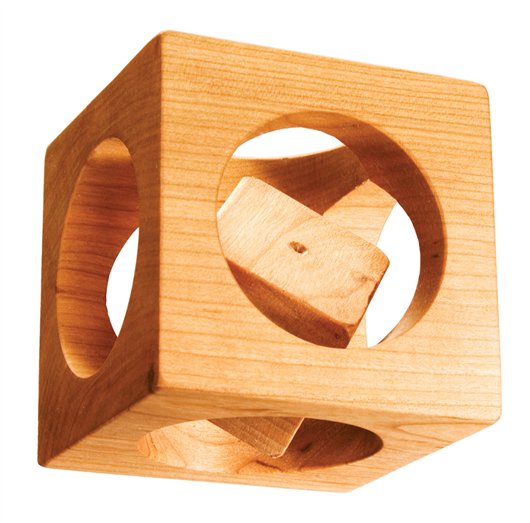We may receive a commission when you use our affiliate links. However, this does not impact our recommendations.
Cube in a Cube
By Jock Holmen
“I'm a carver. I've always admired whittled curiosities like balls trapped inside a cage, but never wanted to spend the time to make them. I figured there must be some way to make a similar object with a drill press. Kids play with it like a toy, but it drives adults nuts. They think it's a puzzle. They're sure there's some way to get the little cube out of the big cube. You can't.”
|
1. Crosscut a 3x3x14-in. blank into four cubes. Solid wood is best, so it doesn't look like you put the little cube in the big cube by gluing parts together. Three-in. table-leg stock works well, but you can make the cubes from 2-1/2 in. or smaller stock if you want. |
Click any image to view a larger version. |
|
3. Set your drill press to run at its slowest speed. Arrange the belts so the smallest diameter drive pulley turns the idler pulley. Connect the idler to the largest diameter spindle pulley. |

|
|
6. Drill holes in the end-grain sides first. Then drill the other four faces. Always place the X's in the same corner relative to the fence and stop block. |

|
|
8. Set the drill bit 1/32-in. deeper and repeat drilling all the holes. Again, drill the end-grain faces first. Use light pressure to avoid breaking the attachment points. |

|
|
10. Release the inner cube by cutting the attachment points with a thin knife, going with the grain. After cutting all eight corners, the inner cube will drop free. But it won't come out! |

|
|
11. Sand the corners of the inner cube. Raise the inner cube above the hole by positioning it at a diagonal. Prop up the cube with a wedge or your fingers. |

|
|
12. Sand burn marks or rough grain with a fine-grit drum-sanding attachment. Rub the drum with a crepe-rubber belt cleaner now and then to keep the drum working efficiently. |
 |
|
14. Dip the cube in oil to finish it. Rub thoroughly with a rag to remove the excess oil, and you're ready to play! |

|
This story originally appeared in American Woodworker September 2007, issue #130.
Here are some supplies and tools we find essential in our everyday work around the shop. We may receive a commission from sales referred by our links; however, we have carefully selected these products for their usefulness and quality.















